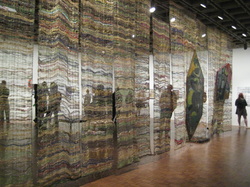
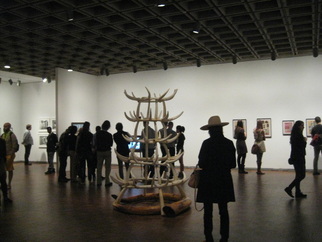
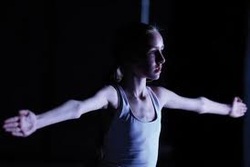
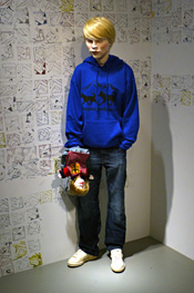
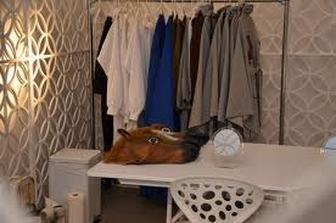
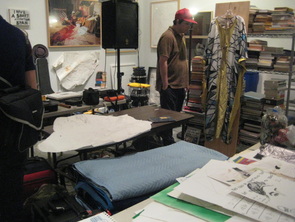
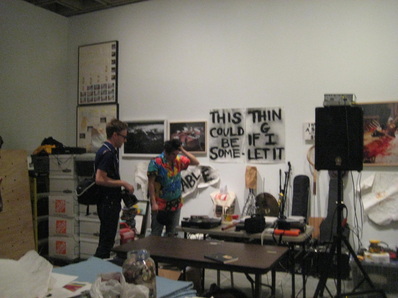
http://whitney.org/Exhibitions/2012Biennial?gclid=CPuZy-b6_64CFUURNAodkwvY4w
| artsmarttalk.com |
|
 The Whitney Biennial has been pretty sickly of late so I was encouraged by reviews calling it the best in years, promising that this one was different, in a good way. I saw it Friday and don't agree - neither the 'best in years' part (though that's a fairly low bar based on the last two or three) or that the art was particularly different.  What was different, not just for the Biennial but for the use and function of a museum, involved performance and process. The art objects - paintings on walls, installations, sculpture, videos - had an almost peripheral relationship within the exhibition; the focus was on the act of art, loosely defined. In that context, viewing the show was as interesting for the experience of seeing others viewing the show as it was for the show itself - it didn't really matter whether the 'performers' were officially sanctioned by the Whitney or had just strolled in to become part of a living tableau for a few hours.  For example, the fourth floor of the museum has been transformed into a performance space in which different types of events take place on different days at different times. When I saw it Friday it was covered by a vast black mat, the setting for a dance class. About 35 people dressed in sloppy old dance class type clothes were standing or sitting, listening to instructions from one of the class leaders. The lighting was strong, coming from one corner, and the scene had the look and feel of a Caravaggio painting - each ordinary, barefoot character took on unearned significance. Then, in a moment, it all shifted - I moved to a different viewpoint, an command was given, the group quickly formed into four straight orderly lines and a whole different set of associations became relevant.  The rest of the floor was a maze of ideas and display. In a tight corner you stumble upon a clever, creepy scene by Gisele Vienne - a blonde boy mannequin holding a bloody-mouthed puppet that jumps to life now and then, as if seeking to take possession of his earthly soul. A breathy voice narrating a tale of horror is presumably the puppet documenting its nasty business. The walls are patterned with penciled squares, each one dirty or marked in a different way, giving the effect of tiles in a cell - which, because you are constrained to stand so close, you inhabit too.  Further down the hall you come to a white space set up like a dressing room for the rotating performers. Touches - the image of a staring sad-eyed woman behind a grill, white patterned panels that recall the screens in mosques or medieval churches, heavy stage lights sprouting like trees in a corner - make the room an installation rather than simply a serviceable space. This Fourth Floor maze has been made one-way so when you reach the end point you have to track back through the narrow spaces, forced to confront by touch and eye contact the tide swimming against you.  The Third Floor includes the installation titled This Could Be Something if I Let It, consisting of the entire studio contents of the artist Dawn Kaspar, who moved just about everything she owns into the Whitney for the three month run of the Biennial. This is certainly process over product, an aim compatible with modern and some historical art, though here product appears to have been dismissed as not really of interest. While I was there the artist milled in and around the throng of people examining her piles of stuff and looking a bit overwhelmed. She claims to have been without a permanent studio for years, so her art is her nomadic existence. She has replicated the Whitney installation elsewhere, moving into a gallery or museum for as long as they will have her.  At the risk of being a Philistine, that doesn't strike me as enough for her to be hailed as an 'artist. or her work as 'art.' But perhaps it's those terms that are the problem, their meaning shifting and dodging as we watch. This year's Biennial, pushing limits and presenting possibilities, makes that definition even harder to pin down. Is that bad? Not necessarily, but neither is it necessarily something to applaud. Maybe the truest thing about the Biennial is that it marches in step with us at this moment in time, when very little is easy to figure out. http://whitney.org/Exhibitions/2012Biennial?gclid=CPuZy-b6_64CFUURNAodkwvY4w
2 Comments
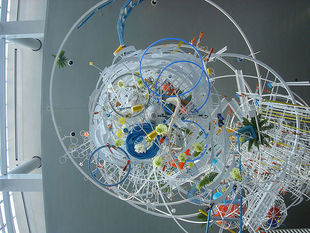 An Equal and Opposite Reaction 2005 Sarah Sze, an artist whose work is rich, fascinating and a bit hard to pin down, has been chosen to represent the U. S. Artist for the upcoming Biennale in Venice, the prestigious international art extravaganza that holds court each summer in and around the familiar tourist spots of that city. I'm particularly happy about the choice - I think Sze is one of the most interesting artists of our time; whatever she does it will be worth the trip to see it. 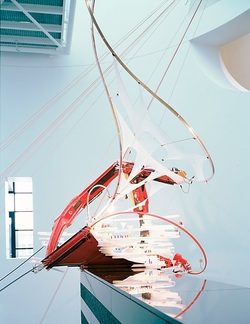 Things Fall Apart 2001 I first came across Sze's work at SF MOMA in 2001 on a class trip with high school students. Her installation Things Fall Apart, hanging from the atrium, snaking up the stairs, sneaking up on you in corners, and sort of dribbling its way into places where you least expected it, provided a great object lesson. Just about everything I needed to say about (good) contemporary art was in the jumbled bits of her art: You're in a partnership of meaning: the art doesn't offer easy answers, it makes you work to figure it out, it doesn't allow you to walk away sure of what it was supposed to mean even if you thought you knew. 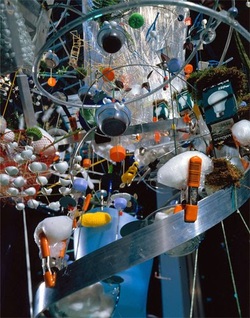 Everything That Rises Must Converge 1999 Things Fall Apart has sort of a car crash theme, but it's jolly rather than gruesome, and the motif is more a convenience than a directive for how to interpret it. There's metal and there are car doors, but there's a lot of other stuff too. 'Stuff' is Sze's stock in trade, and it's amazing how she uses it to put her finger on the pulse of this frantic, fractured historical moment. In articles about her work writers grope for ways to describe it - 'organized chaos' is a popular phrase. It's perhaps easier to begin, as she does, with the 'stuff' - an incomplete list of her materials includes Qtips, tea bags, salt, light bulbs, plastic toys, feathers, twigs, dried flowers, tape, pebbles..... There can be no end to the list because everything is fair game. 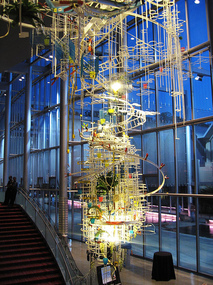 An Equal and Opposite Reaction 2005 Her installations are at once energizing and soothing; they fit the universe we've either embraced or accepted, one of too much information zooming at us from every direction. In what she does we recognize the struggle to keep up and make sense of it. In some sense she's taken the old 19th century 'cabinet de curiosities' concept and exploded it, super-sized it, blown it - literally - to bits. 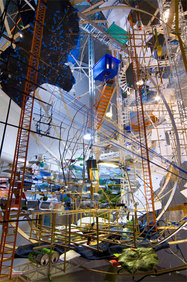 360 Portable Planetarium 2009 Sze builds her pieces on site, creating the impression of organic, random growth, but she clearly has a very rational mind and follows a plan, often worked out beforehand in her Brooklyn studio. She has an immense gift for maximizing the serendipity of space, time, color, form, texture .... and just about everything else. The images shown here are in each case sections installations - a single photograph can never contain the sprawling multiplicity of her work. (Her recent construction for the High Line in New York, intentionally created to be a habit for the beleaugured songbirds of the city, is the 'tamest' of all that I've seen and comes closest to being visible from one spot.) 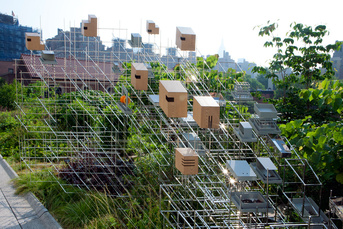 Still Life with a Landscape (The High Line NYC 2011) Sarah Sze's life story is not as long as you'd think for someone doing work of this assurance and maturity; she graduated from Yale in 1991, got a master's from SVA in New York in 1997, and two years later had a landmark exhibition at the Fondation Cartier in Paris, an event that riveted attention on a new star. In 2003 she was the recipient of a MacArthur 'Genius Grant. Sarah Sze is featured in the next PBS Art 21 series about living artists, available in April. Here's a link to the trailer: http://www.pbs.org/art21/watch-now/trailer-season-6-of-art-in-the-twenty-first-century-2012 (note: Sze is in great company with a slate of artists with strong, interesting ideas) images courtesy of the artist, the Tanya Bodaktar Gallery, the New York Times, and others 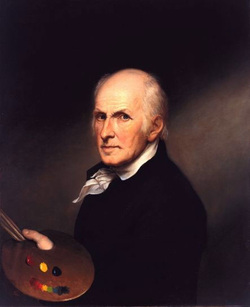 Self-Portrait Charles Wilson Peale 1822 What DO American politicians look like? Have they always had pasty tans, over-gelled hair, and flag pins in their lapels? Thankfully no - there's plenty of evidence for a different model. Not to say that politics was ever a kind and gentle sport, but, thanks to an artist who played a part in the founding of the country, we have a vivid way of considering the nature of early politicians. Washington? Of course. We all know the painfully set jaw, the white wig, the stiff military posture, the disaffected presidential gaze. But there are other versions: ask Charles Wilson Peale, one of the most interesting, entrepreneurial artists this country has ever produced. 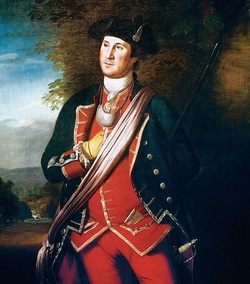 George Washington by Peale 1772 Peale painted 60 versions of Washington, including this 1772 portrait, the earliest known depiction. Washington, wearing the uniform of his regiment from the French and Indian war, was at the time merely a Virginia farmer, though he was also starting to voice his opposition to oppressive British policies. 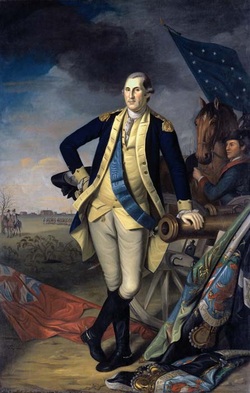 George Washington by Peale 1781 Peale's 'Princeton Portrait' of Washington shows him 9 years later in full American Revolution regalia after a decisive battle, with all the trappings of a European state portrait. Elegant, fashionable, surrounded by paraphernalia and attributes, Washington is loudly proclaimed a man of great character and deed. The painting (for which Washington posed) is thought to have been commissioned by Martha Washington. (Not one for 'photo ops,' Washington sat only a few times for Peale - Peale (the entrepreneur part) made good use of his resources to produce all those versions and numerous copies, including 18 of the Princeton portrait.) 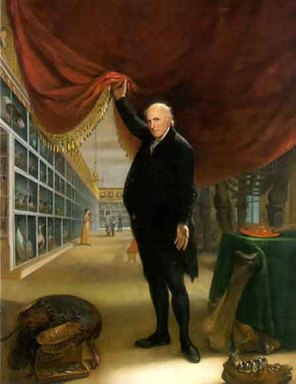 The Artist in his Museum (Self-Portrait) 1822 Charles Wilson Peale, himself a loyal patriot born and bred in the colonies who fought alongside Washington, left a treasury of portraits of colonial movers and shakers, many which can be seen in a Portrait Gallery just down the street from Independence Hall in Philadelphia. Peale, an ideal of the American pioneering spirit of inventiveness and pragmatic 'just-get-it-done' achievement, was a politician, a soldier, a fund-raiser, a naturalist, the founder of the first American museum for both art and science, the founder of the first American art school, the sponsor of the first American art exhibit, and, by some accounts, could also fix your teeth, shoes, and furniture. He also had 16 children, several of who went on to become artists and found their own museums. Peale's museum was originally on the second floor of what is now Independence Hall - the mastodon that used to be the main attraction is long gone, but his paintings now form the collection in the Portrait Gallery. 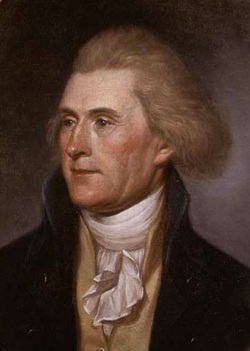 Thomas Jefferson by Peale 1781 Even when the subjects have lost their 'household name' familiarity, the history they reveal is fascinating. Peale, who studied for three years in London, manages a gloss of European sophistication of technique and observation without losing a kind of American honesty - the paintings are a rich aesthetic experience as well as an historic one. This portrait of Thomas Jefferson is remarkable for the life in the expression and the subtleties of color and touch. 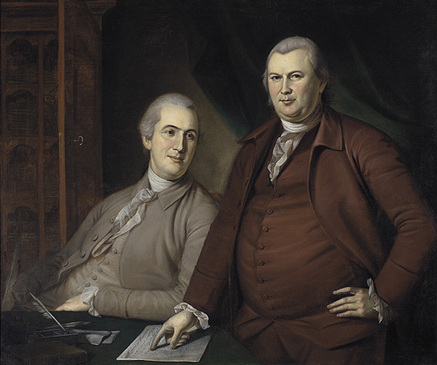 Gouverneur Morris and Robert Morris by Peale 1783 This double portrait of Robert Morris and Gouvernor Morris - not related, but linked by time and effort for the American cause as well as by name - is a nice example of Peale's relaxed but respectful approach. Gouverneur Morris slouches at the left, a little cocky but with a twinkle in his eye. The bright son of a wealthy New York loyalist family, Morris authored sections of the Constitution, and despite a wooden leg, was a notorious charmer of the ladies. Though he favored a more aristocratic standard for democracy, he opposed slavery and argued strongly for religious freedom. 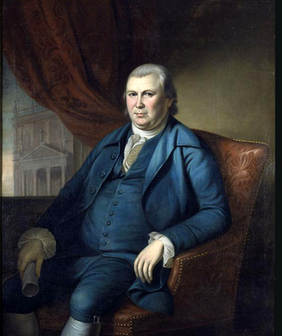 Robert Morris by Peale 1782 Robert Morris, shown also in this portrait, was a very wealthy merchant and businessman, a man of integrity who financed much of the Revolution, including providing for the starving, freezing troops under Washington out of his own pocket. He also stepped up to create a clear financial plan for the young country and establish the first national bank. His investments of time and money never paid off for him, however, and he died in relative poverty. Selflessness and dedication to the greater good - those ideas are in the fabric of the lives in these portraits - scientists, soldiers, intellectuals, artists, explorers, women in various capacities, and yes - politicians. They don't have to go bankrupt, but could we have a bit of that these days, please? Here's a link to the Portrait Gallery, located in the Second National Bank building in Philadelphia. http://www.nps.gov/inde/second-bank.htm (note: many, but not all portraits shown are in the Portrait Gallery) 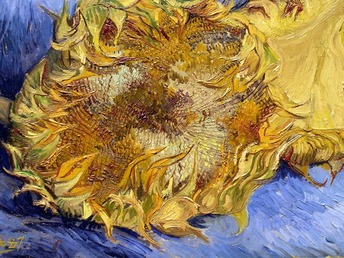 Sunflowers 1887 Van Gogh is not everyone's favorite artist, though, from the long lines to see Van Gogh Up Close at the Philadelphia Museum, you might think so. The wait (even with my member's ticket) gave me a chance to think about several things. First - the idea of 'favorite.' I certainly understand 'not favorite' - in fact, to be honest, I think the choice of Van Gogh as a favorite artist is a bit naive. But I've also heard 'I don't like Van Gogh.' That's harder to understand. What don't you like? His impeccable sense of color harmonies? His astounding inventiveness with line and composition? And, of course, there's his dramatic, heart-wrenching life story. I can't imagine not 'liking' Van Gogh - he's too earnest and eager to please, like a child, albeit one who was supremely gifted and very brave. 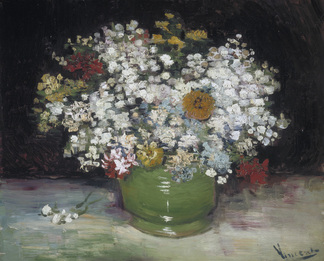 Vase with Zinnias 1886 The PMA exhibit is titled 'Up Close' because it focuses on his attention to nature, including still lifes and studies of flowers and plants. The title is a bit misleading. There are plenty of broader landscapes as well, just not much in the way of portraits or people. Like many exhibits the organization is by date, earlier to late, but with Van Gogh that isn't terribly significant because almost all of his great works erupted from him in the last three to five years of his life. Even so, the progression is interesting - a few floral studies, startlingly conventional, begin the journey. You can see him struggling to square the set images in his mind - traditional Dutch still life paintings of big bouquets in vases, centered in a darkened space - with new ideas from the Impressionists he'd just met in Paris. If he'd stopped with the ones on view no one would know his name. I have a particular love of Van Gogh's vocabulary of line, one of the most extraordinary, extensive resources of mark-making of any artist or period. In paintings like Vineyards at Auvers and Tree Trunks in the Grass, you see him stroking, slashing, dotting, dragging, squiggling, chopping and wisping his color onto the surface, weaving an endlessly inventive visual fabric. 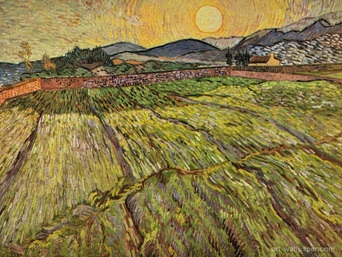 Landscape with Plowed Field 1889 One of the most moving paintings in the show is Landscape with Plowed Field, a serene scene of man and nature working together to produce a world of order; a huge sun, a close cousin to the moon in Starry Night, hovers like a benevolent god over neatly plowed fields, a tidy stone fence, and a pleasing range of moderate hills. But, cutting across the lower third, a rough messy diagonal upsets the calm - it turns out to be the path trod by Van Gogh's fellow inmates in the asylum at St. Remy - the view is out through the bars of his room. 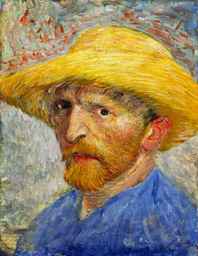 Self-Portrait With Straw Hat 1887 Another thought as I waited in line - Van Gogh would have loved this show, the crowds, the gift shop with all the sunflower tchotchkes - if you read his letters (very recommended, especially if you think he was just a loony as some people seem to - he was a lucid, intelligent, articulate writer with a deep knowledge of art) you find that his mission in life was to do something good for people, something that would make a difference in their lives. He may not have seen much success or money while he was alive, but he sure accomplished that. Van Gogh Up Close is at the Philadelphia Museum of Art through May 6, 2012 http://www.philamuseum.org/exhibitions/743.html |
Share ArtSmartTalk
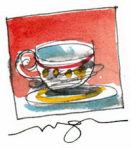
MacGregor-Art.com Cards and art gifts with a Fine Sense of Fun Also at http://www.etsy.com/shop/MacGregorArt ArtSmart Consulting
|
| Blog: |
| ArtSmartTalk |
Topics: |
| Art History, Design, Art |
All
19th C Art4a3f8ec7db
20th C59300e1f29
African Art
Almutanabbi Streetbb1c3786e2
American Art
Ann Hamilton
Apple
Apple Computers
Arabic Poetry
Architecture
Art
Art And Nature
Art And Technology
Art As Collective Memory
Art Auctions
Art Books
Art Forgery
Art Galleries
Art History
Art In Gardens
Art Installation
Art Installations
Art Licensing
Art Of Spain
Art Prints
Art Technology
Baghdad Books
Barnes Collection
Biennial
Book Project
Books
Brooklyn Museum
California Design
Chelsea Galleries
Chess
Color
Constable
Contemporary Architecture
Contemporary Art
Contemporary Design
Design
Detroit Institute Of Arts
Drawing
E H Shepard
El Anatsui
Etching
European Art
Expressionism
Fabric Design
Flags
Folk Art
French Art
French History
French Portraits
Galleries
George Bellows
Goya
Goya Black Paintings
Goya Portrait
Hand-made Books
Historical Art
Hokusai
Ho Tanner
Illustration
Installation Art
Iraq
Jean Clouet
Lacma
Lewis Chessmen
London
Los Angeles
Mac Computers
Mary Cassatt
Matisse
Met Museum
Metropolitan Museum
Metropolitan Museum Of Art
Modern Art
Modern British Painting
Moma
Moma Ps1
Moons
Museums
Napoleon
National Gallery
Nature
New Architecture
New Art
New Design
New Goya Painting
New York
New York Art
Norse Art
Novels About Art
Old City Philadelphia
Online Art Sites
Outdoor Art
Outsider Art
Painting
Paris
Pat Steir
Performance Art
Philadelphia
Philadelphia Art
Philadelphia Museum
Photography
Plein Air
Portraits
Product Design
Red
Religious Art
Rembrandt
Rome
Rothko
Royal Portraits
Sarah Sze
Scottish Art
Self-portraits
Significance Of Art
Sketching
Southern California
Soutine
Spanish Art
Spanish History
Steve Jobs
Technology
Thanksgiving
The Importance Of Art
Turner
Van Gogh
Velasquez
Venice Biennale
Whitney Museum
Words And Art
Young Artists
August 2013
May 2013
February 2013
January 2013
December 2012
November 2012
October 2012
September 2012
August 2012
July 2012
June 2012
May 2012
April 2012
March 2012
February 2012
January 2012
December 2011
November 2011
October 2011
September 2011
August 2011
July 2011